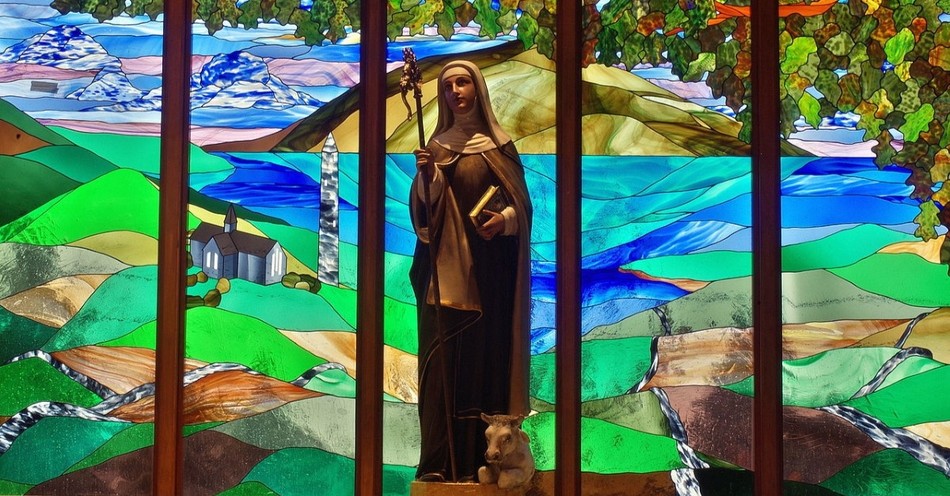March 17 rolls around, and people worldwide celebrate in various ways. Most celebrations will involve some Irish decorations like a green clover. Catholics and other high-church Christians remember St. Patrick, one of the most popular saints and evangelists in history, the person responsible for converting a whole nation to Christianity.
But he didn’t do it alone. Ireland has two other main saints: St. Columba and St. Brigid.
Brigid is considered a pillar of Irish Christianity. A contemporary of Patrick, St. Brigid started monasteries and schools in and around Kildare. Many sources claim St. Brigid and St. Patrick worked together as pillars of Christianity in Ireland, and many miraculous works are attributed to both.
Not only is Brigid one of the three patron saints of Ireland. She’s also the patron saint of poets, newborn babies, blacksmiths, brewers, Irish nuns, chicken farmers, dairymaids, scholars, fugitives, and more.
Whether or not we belong to denominations that canonize saints and commemorate them on special days, we can still remember historic Christians who have served God. As we celebrate Ireland’s Christian heritage with the amazing Celtic cross and other symbols, let’s take a moment to remember this important woman.
Key Events in the Life of St. Brigid
Much of what we know of St. Brigid comes from secondary sources, and scholars debate how much is legend or myth and how many events are factual.
From the story handed down and written later, Brigid’s mother, Brocca, was a slave of a Leinster chieftain by the name of Dubthach. When Dubthach’s wife found out Brocca was pregnant by her husband, she demanded the pregnant woman be sold to a Druid landowner. Brocca named her daughter Brigit, who we know as Brigid, upon her birth in 451 AD.
Brigid grew up and was known for giving to the poor, sometimes in miraculous ways. At 10 years old, she returned to her father, the chieftain. Brigid began to give away Dubthach’s possessions, and he got tired of her donating his things to others.
Dubthach tried to sell Brigid to the Leinster king. While they discussed the transaction, Brigid took Dubthach’s jeweled sword and gave it to a poor person to sell and feed their family. Seeing this, the king (who was a Christian) told Dubthach to set the child free.
Being free, she returned to her mother, continuing to give milk away. However, the druid’s dairy farm prospered. Once she grew of age, Dubthach tried to marry her off, but she refused, choosing to stay committed to God. She entered the Church, supposedly ordained by St. Patrick, who declared she was destined for great things.
At 40 years old, Brigid founded a monastery in Kildare called the Church of the Oak (ironically built above an older shrine to the Celtic goddess of the same name, Brigid). Later, she and seven friends founded a religious community dedicated to a consecrated life. At some point, she started two monastic organizations, one for men and another for women.
Brigid invited a hermit, Conleth, to assist her in administrating Kildare. Conleth eventually co-ran the ministry. She started an art school in Kildare. Among other projects, the school created the Book of Kildare, called the work of angels because of its beauty. The book is now lost, having disappeared during the Protestant Reformation.
Brigid passed away on February 1, 525 AD.
Why Do We Remember St. Brigid?
Like her contemporary St. Patrick, St. Brigid’s efforts supported and furthered Christianity throughout Ireland. As a legacy, she began several monasteries and nunneries. The work in Kildare, including the art school, continued to be run by an abbot-abbottess partnership for centuries. The religious landscape of Kildare and much of Ireland became more Christian during her lifetime and leadership.
She is remembered for her extreme charity to the poor and, like many saints, for her miracles. Even evangelical Christians who question the concept of canonizing saints and how many of the miraculous accounts are genuine can learn something from these accounts. If nothing else, they show that saints are remembed as devout believers that God used in surprising ways.
The miracles attributed to Brigid are diverse. She was an expert dairywoman and brewer, and it is said she could transform water into beer. Her prayers were reported to stop the rain and storms.
One story includes the blessing and cursing of trees. Brigid was given a gift of apples and passed them on to a group of lepers in a house. The woman who gave the apples criticized Brigid for wasting the apples. Brigid cursed the woman’s trees to never bear fruit again, and they didn’t. Another woman gave Brigid some apples, which were again passed on to lepers. That woman asked Brigid to bless her trees to bear twofold. Brigid prayed. The trees became double fruitful.
Along with St. Patrick and St. Columba, St. Brigid’s work spreading Christianity continued beyond her own country. Within a few hundred years, Irish missionaries spread to Scotland and Europe.
Quotes Attributed to St. Brigid
“I should like a great lake of ale, for the King of Kings. I should like the family of Heaven to be drinking it throughout time eternal.”
“It is a virtue and a prize to listen patiently and put up with insults for the sake of God.”
“Blessed be thou, my Lord Jesus Christ, who didst foretell thy death before the time, and in the Last Supper didst wonderfully consecrate thy body of material bread, and also charitably gave it to thy apostles, in memory of thy most worthy passion.”
“O Jesus! Remember the sadness that Thou didst experience when, contemplating in the light of Thy divinity the predestination of those who would be saved by the merits of Thy sacred passion, thou didst see at the same time the great multitude of reprobates who would be damned for their sins, and Thou didst complain bitterly of those hopeless, lost, and unfortunate sinners.”
“I would like the angels of Heaven to be among us.
I would like an abundance of peace.
I would like full vessels of charity.
I would like rich treasures of mercy.
I would like cheerfulness to preside over all.
I would like Jesus to be present.
I would like the three Marys of illustrious renown to be with us.
I would like the friends of Heaven to be gathered around us from all parts.
I would like myself to be a rent payer to the Lord; that I should suffer distress, that he would bestow a good blessing upon me.
I would like a great lake of beer for the King of Kings.
I would like to be watching Heaven’s family drinking it through all eternity.”
When Is St. Brigid’s Day?
Like many saints, St. Brigid has a feast day associated with her. In her case, the day is February 1.
Feast days often coincide with traditional festivals which existed before Christianity became a country’s primary religion. In Ireland, February 1 was originally Imbolc, an Irish celebration of the first day of spring mentioned in various Irish myths and ancient writings.
As the green isle became Christianized, the holiday was also converted to honor Brigid. There is an interesting irony here. As stated before, Brigid is also the name of an ancient Irish goddess of fire. Today, St. Brigid is honored with a perpetual fire in Kildare.
There are several traditions associated with St. Brigid’s Day. One is leaving a piece of clothing out for St. Brigid to bless on the eve of St. Brigid’s Day. The cloth is brought inside in the morning and is believed to have healing powers.
Like many feast traditions, Christians (even within high-church traditions that follow feast days and name individual Christians as saints) have a variety of opinions on whether these traditions work and should be continued. Evangelical Christians discourage these practices.
Further Reading:
What Can We Learn from the Life of St. Patrick?
The Celtic Missionaries of Ireland
Ireland's Author-Evangelist Adamnan
Patrick: From Slave to Missionary
Death of Ireland's St. Colman Ela
What Is St. Patrick's Day All About?
Patrick: Making of a Missionary
Photo Credit: Nheyob/Wikimedia Commons

This article is part of our People of Christianity catalog that features the stories, meaning, and significance of well-known people from the Bible and history. Here are some of the most popular articles for knowing important figures in Christianity:
How Did the Apostle Paul Die?
Who are the Nicolaitans in Revelation?
Who Was Deborah in the Bible?
Who Was Moses in the Bible?
King Solomon's Story in the Bible
Who Was Lot's Wife in the Bible?
Who Was Jezebel in the Bible?
Who Was the Prodigal Son?


.jpg)
